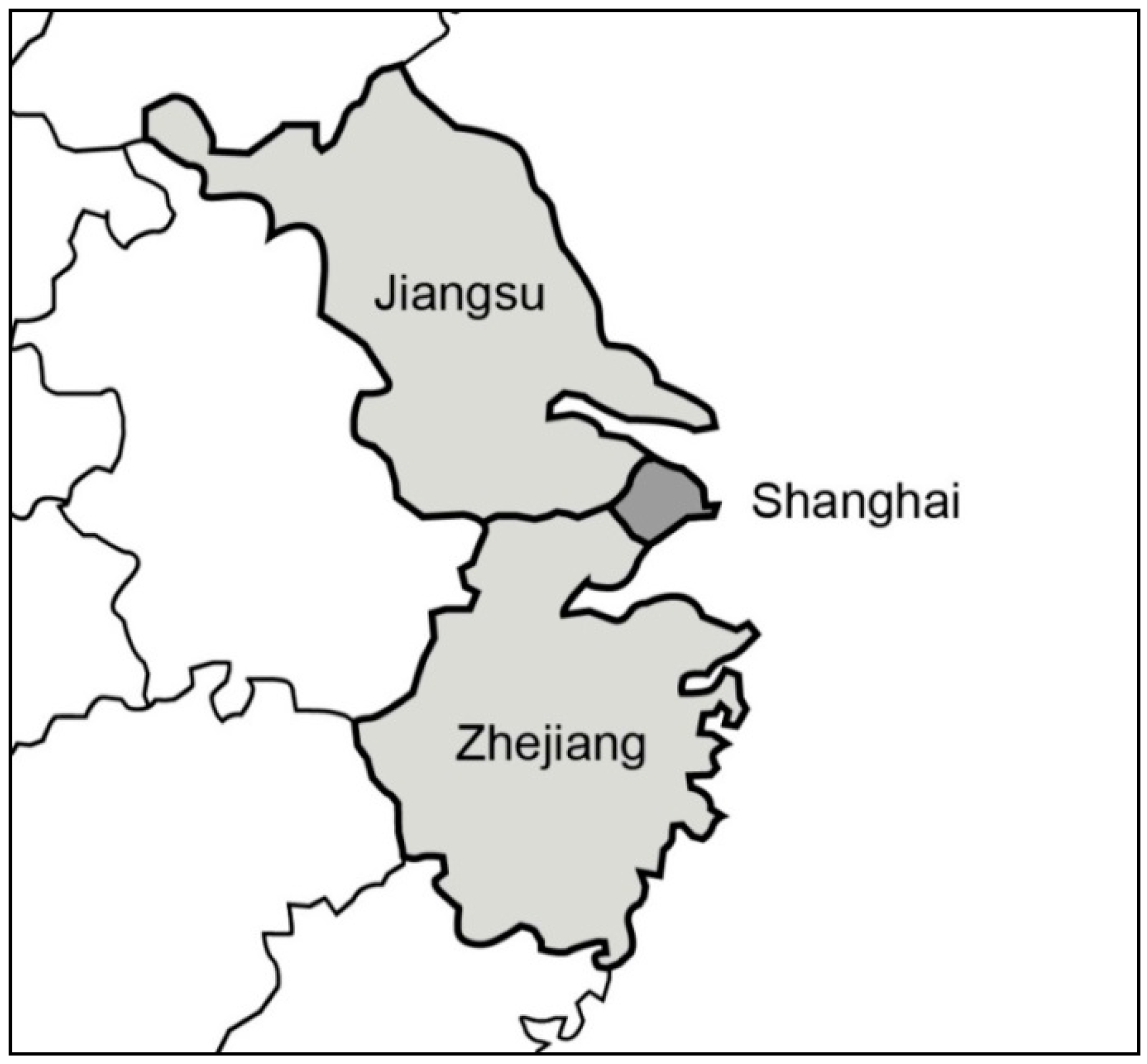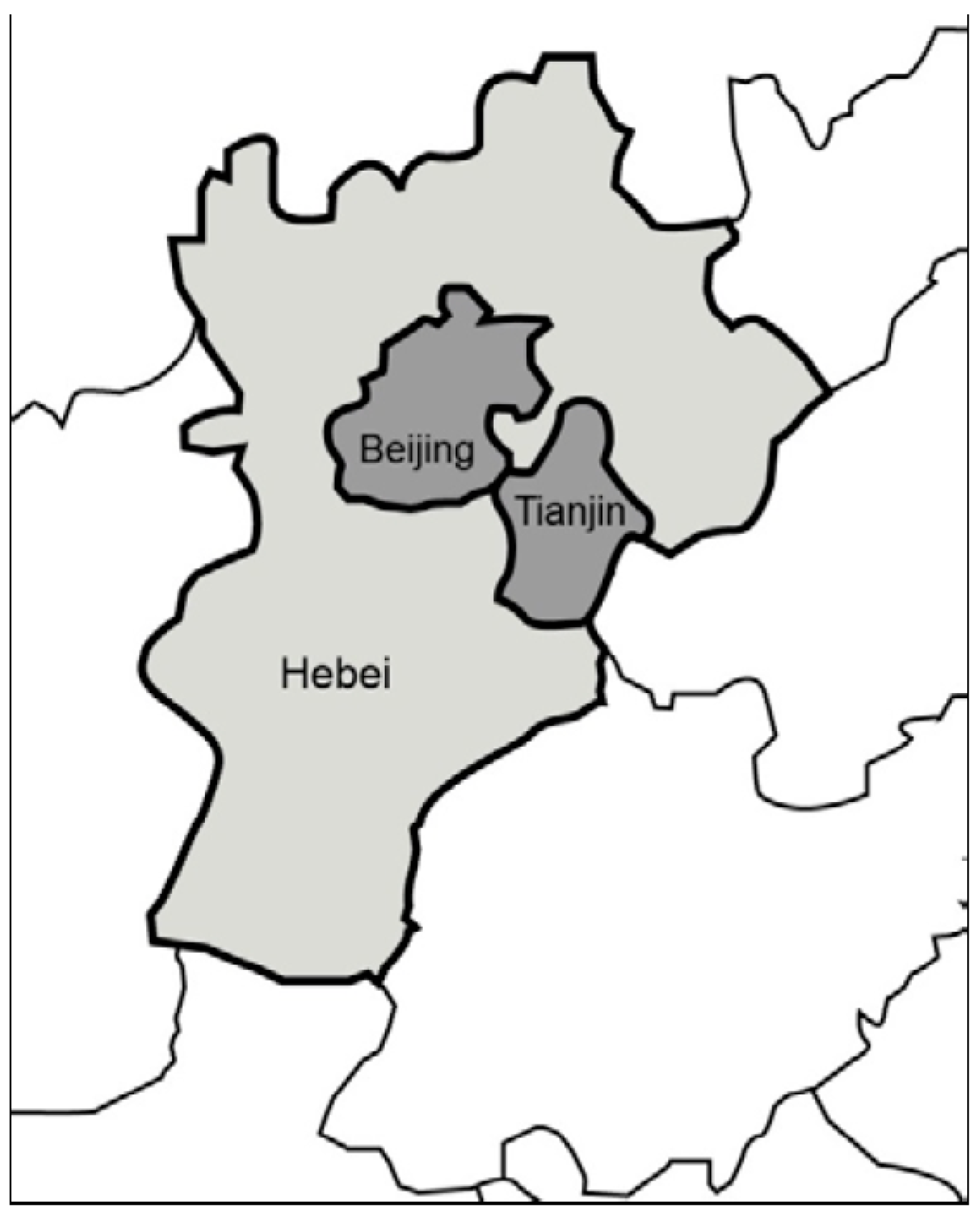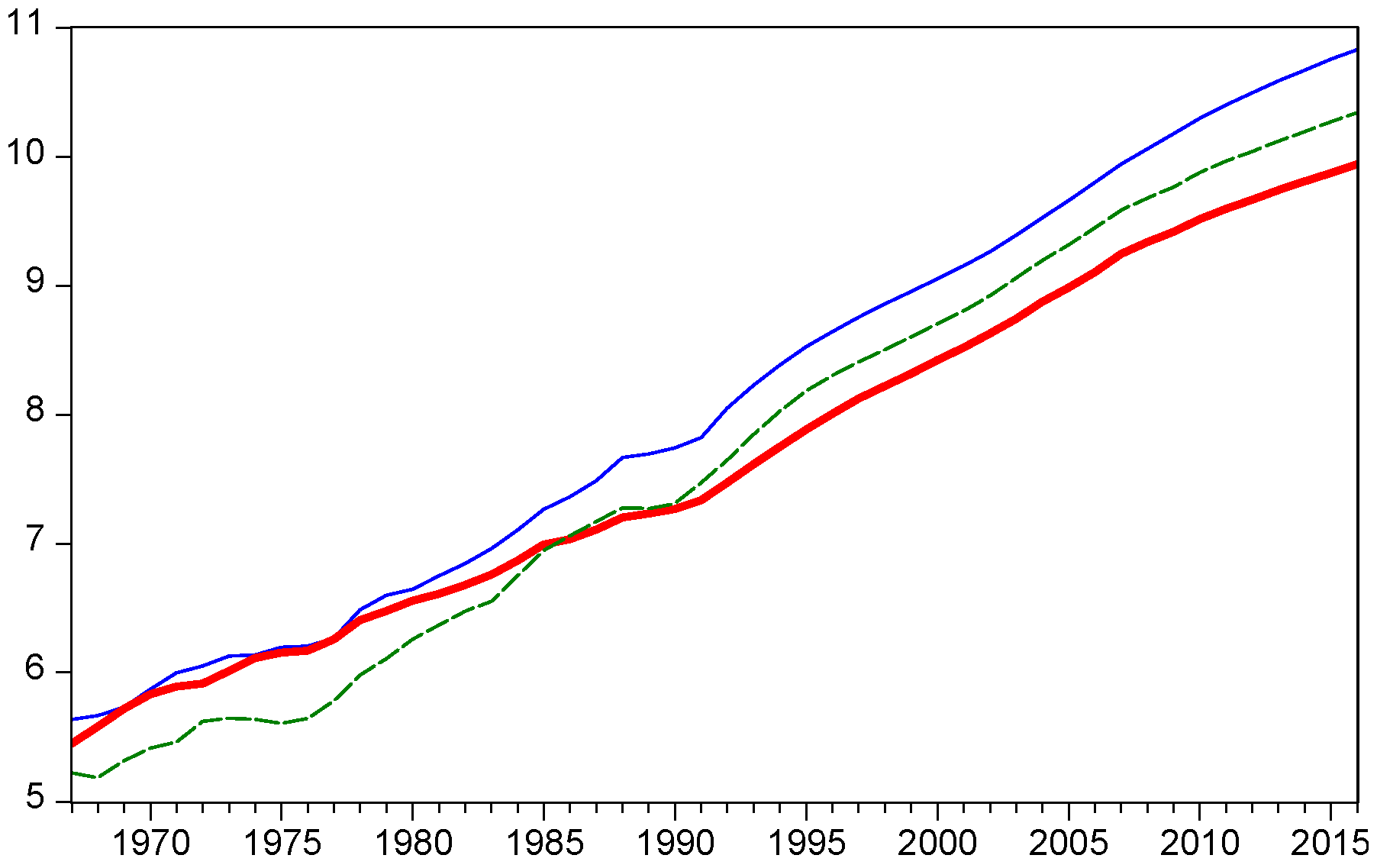Assessing the Merits of the Urban-Led Policy in China: Spread or Backwash Effect?
Abstract
:1. Introduction
2. Review of the Central-Suburban Relationship
3. Empirical Model and Data Description
3.1. Economic Models and the ECM
3.2. Data Description
3.3. Two Metropolitan Regions: Beijing and Shanghai
3.4. Data Analysis and Unit Root Tests
4. Estimation Results and Policy Implications
4.1. Estimation Results: Co-Integration
4.2. Long-Run Causalities: Weak Exogeneity Tests
4.3. Policy Implications
5. Conclusions
Acknowledgments
Conflicts of Interest
References
- Ke, S.; Feser, E. Count on the growth pole strategy for regional economic growth? Spread-backwash effects in greater Central China. Reg. Stud. 2010, 44, 1131–1147. [Google Scholar] [CrossRef]
- Chen, A.; Partridge, M.D. When are cities engines of growth? Spread and backwash effects across the Chinese urban hierarchy. Reg. Stud. 2013, 47, 1313–1331. [Google Scholar] [CrossRef]
- Yang, D.T. Urban-biased policies and rising income inequality in China. Am. Econ. Rev. 1999, 89, 306–310. [Google Scholar] [CrossRef]
- Perroux, F. Economic space: Theory and application. Q. J. Econ. 1950, 64, 89–104. [Google Scholar] [CrossRef]
- Boarnet, M.G. The monocentric model and employment location. J. Urban Econ. 1994, 40, 45–57. [Google Scholar] [CrossRef]
- Carlino, G.A.; Mills, E.S. The determinants of county growth. J. Reg. Sci. 1987, 27, 39–54. [Google Scholar] [CrossRef] [PubMed]
- Deitz, R. A joint model of residential and employment location in urban areas. J. Urban Econ. 1998, 44, 197–215. [Google Scholar] [CrossRef]
- Ganning, J.P.; Baylis, K.; Lee, B. Spread and backwash effects for nonmetropolitan communities in the U.S. J. Reg. Sci. 2013, 53, 464–480. [Google Scholar] [CrossRef]
- Henry, M.S.; Schmitt, B.; Kristensen, K.; Barkley, D.L.; Bao, S. Extending Carlino-Mills models to examine urban size and growth impacts on proximate rural areas. Growth Chang. 1999, 30, 526–548. [Google Scholar] [CrossRef]
- Richardson, H.W. Growth pole spillovers: The dynamics of backwash and spread. Reg. Stud. 1976, 10, 1–9. [Google Scholar] [CrossRef]
- Wang, X.; Hui, E.C.; Choguill, C.; Jia, S. The new urbanization policy in China: Which way forward? Habitat Int. 2015, 47, 279–284. [Google Scholar] [CrossRef]
- Boudeville, J.R. Problems of Regional Economic Planning; Edinburgh University Press: Edinburgh, UK, 1966. [Google Scholar]
- Hirschman, A.O. The Strategy of Economic Development; Yale University Press: New Haven, CT, USA, 1961. [Google Scholar]
- Myrdal, G. Economic Theory and Underdeveloped Regions; Harper & Row: New York, NY, USA, 1957. [Google Scholar]
- Haughwout, A. Management of large city regions: Designing efficient metropolitan fiscal policies. J. Reg. Sci. 2010, 50, 401–421. [Google Scholar] [CrossRef]
- Gaile, G.L. The spread-backwash concept. Reg. Stud. 1980, 14, 15–25. [Google Scholar] [CrossRef]
- Savitch, H.V.; Collins, D.; Sanders, S.; Markham, J.P. Ties that blind: Central cities, suburbs and the new metropolitan region. Econ. Dev. Q. 1993, 7, 341–357. [Google Scholar] [CrossRef]
- Hill, E.W.; Wolman, H.L.; Ford, C.C., III. Can suburbs survive without their central cities? Examining the suburban dependent hypothesis. Urban Aff. Rev. 1995, 31, 147–174. [Google Scholar] [CrossRef]
- Hollar, M.K. Central cities and suburbs: Economic rivals or allies? J. Reg. Sci. 1958, 51, 231–252. [Google Scholar] [CrossRef]
- Howe, S.R.; Allor, D.; Bier, T.; Finnerty, T. The shrinking central city amidst growing suburbs: Case of Ohio’s inelastic cities. Urban Geogr. 1998, 19, 714–734. [Google Scholar] [CrossRef]
- Kolenda, R.; Liu, C.Y. Are central cities more creative? The intrametropolitan geography of creative industries. J. Urban Aff. 2012, 34, 487–512. [Google Scholar] [CrossRef]
- Savitch, H.V.; Vogel, R.K. Suburbs without a city: Power and city-county consolidation. Urban Aff. Rev. 2004, 39, 758–790. [Google Scholar] [CrossRef]
- Voith, R. City and Suburban Growth: Substitutes or Complements? Business Review; Federal Reserve Bank of Philadelphia: Philadelphia, PA, USA, 1992. [Google Scholar]
- Voith, R. Do suburbs need cities. J. Reg. Sci. 1992, 38, 445–464. [Google Scholar] [CrossRef]
- Hughes, D.W.; Holland, D.W. Core-periphery economic linkage: A measure of spread and possible backwash effects for the Washington economy. Land Econ. 1994, 70, 364–377. [Google Scholar] [CrossRef]
- Palumbo, G.; Sacks, S.; Wasylenko, M. Population decentralization with metropolitan areas: 1970–1980. J. Urban Econ. 1957, 27, 151–167. [Google Scholar] [CrossRef]
- Leichenko, R.M. Growth and change in U.S. cities and suburbs. Growth Chang. 2001, 32, 326–354. [Google Scholar] [CrossRef]
- Ferguson, M.; Ali, K.; Olfert, M.R.; Partridge, M. Voting with their feet: Jobs versus amenities. Growth Chang. 2007, 38, 77–110. [Google Scholar] [CrossRef]
- Barkley, D.L.; Henry, M.S.; Bao, S. Identifying ‘spread’ versus ‘backwash’ effects in regional economic areas: A density functions approach. Land Econ. 1996, 72, 336–357. [Google Scholar] [CrossRef]
- Schmitt, B. Economic geography and contemporary rural dynamics: An empirical test on some French regions. Reg. Stud. 2000, 33, 697–711. [Google Scholar] [CrossRef]
- Schmitt, B.; Henry, M.S.; Piguet, V.; Hilal, M. Urban growth effects on rural population, export and service employment: Evidence from Eastern France. Ann. Reg. Sci. 2006, 40, 779–801. [Google Scholar] [CrossRef]
- Carruthers, J.I.; Vias, A.C. Urban, suburban, and exurban sprawl in the Rocky Mountain west: Evidence from regional adjustment Models. J. Reg. Sci. 2005, 45, 21–48. [Google Scholar] [CrossRef]
- Ke, S. Determinants of economic growth and spread-backwash effects in Western and Eastern China. Asian Econ. J. 2010, 24, 179–202. [Google Scholar] [CrossRef]
- Ying, L.G. Measuring the spillover effects: Some Chinese evidence. Pap. Reg. Sci. 2000, 79, 75–89. [Google Scholar] [CrossRef]
- Brun, J.F.; Combes, J.L.; Renard, M.F. Are there spillover effects between coastal and noncoastal regions in China? China Econ. Rev. 2002, 13, 161–169. [Google Scholar] [CrossRef]
- Fu, X. Limited linkage from growth engines and regional disparities in China. J. Comp. Econ. 2004, 32, 148–164. [Google Scholar] [CrossRef]
- Schmitt, B.; Henry, M.S. Size and growth of urban centers in French labor market areas: consequences for rural population and employment. Reg. Sci. Urban Econ. 2000, 30, 1–21. [Google Scholar] [CrossRef]
- Hunt, G.L. Population-employment models: Stationarity, cointegration and dynamic adjustment. J. Reg. Sci. 2006, 46, 205–244. [Google Scholar] [CrossRef]
- Freeman, D.G. Sources of fluctuations in regional growth. Ann. Reg. Sci. 2001, 35, 249–266. [Google Scholar] [CrossRef]
- Chang, C.; Coulson, N.E. Sources of sectoral employment fluctuation in central cities and suburbs: Evidence from four eastern U.S. cities. J. Urban Econ. 2001, 49, 199–218. [Google Scholar] [CrossRef]
- Solé-Ollé, A.; Viladecans-Marsal, E. Central cities as engines of metropolitan area growth. J. Reg. Sci. 2004, 44, 321–350. [Google Scholar] [CrossRef]
- Chiang, S. The dilemma of “Twin Cities”: Is the suburban dependence hypothesis applicable? J. Econ. Policy Reform 2014, 17, 149–163. [Google Scholar] [CrossRef]
- Groenewold, N.; Lee, G.; Chen, A. Regional output spillovers in China: Estimates from a VAR model. Pap. Reg. Sci. 2007, 86, 101–122. [Google Scholar] [CrossRef]
- Groenewold, N.; Lee, G.; Chen, A. Inter-regional spillovers in China: The importance of common shocks and the definition of the regions. China Econ. Rev. 2008, 19, 32–52. [Google Scholar] [CrossRef]
- Engle, R.F.; Yoo, B. Co-integration and error correction: Representation, estimation and testing. Econometrica 1987, 55, 251–276. [Google Scholar] [CrossRef]
- MacKinnon, J.G. Critical values for cointegration tests. In Long-Run Economic Relationships: Readings in Cointegration; Engle, R.F., Granger, C.W.J., Eds.; Oxford University Press: Oxford, UK, 2016; pp. 267–276. [Google Scholar]
- MacKinnon, J.G.; Haug, A.A.; Michelis, L. Numerical distribution functions of likelihood ratio tests for cointegration. J. Appl. Econ. 1991, 14, 563–577. [Google Scholar] [CrossRef]
- Lee, C.; Chien, M. Empirical modeling of regional house prices and the ripple effect. Urban Stud. 2011, 48, 2029–2047. [Google Scholar] [CrossRef]
- Lee, C.; Chiang, S. Ripple Effect and Regional House Prices Dynamics in China. Int. J. Strateg. Prop. Manag. 2016, 20, 397–408. [Google Scholar] [CrossRef]





| Industrial Structure (%) | GRP Per Capita (RMB) | |||
|---|---|---|---|---|
| Primary | Secondary | Tertiary | ||
| YRD metropolitan region | ||||
| Shanghai | 0.44 | 31.81 | 67.76 | 103,796 |
| Jiangsu | 5.68 | 45.7 | 48.61 | 87,995 |
| Zhejiang | 4.27 | 45.96 | 49.76 | 77,644 |
| JJJ metropolitan region | ||||
| Beijing | 0.61 | 19.74 | 79.65 | 106,497 |
| Tianjin | 1.26 | 46.58 | 52.15 | 107,960 |
| Hebei | 11.54 | 48.27 | 40.19 | 40,255 |
| 0.834 (5) | −0.075 (5) | −2.858 (5) | |
| 13.931 (0) | 1.857 (0) | −4.203 *** (1) | |
| 3.122 (1) | 0.173 (1) | −3.428 * (1) | |
| 7.078 (2) | 0.261 (2) | −2.326 (2) | |
| 6.807 (2) | 3.175 (2) | −0.514 (2) | |
| 2.120 (4) | 1.491 (2) | −2.418 (2) | |
| −0.660 (4) | −6.382 *** (4) | −6.719 *** (1) | |
| −1.598 (1) | −5.238 *** (0) | −5.609 *** (0) | |
| −1.673 * (0) | −3.868 *** (0) | −3.825 ** (0) | |
| −0.736 (8) | −9.536 *** (1) | −9.455 ** (1) | |
| −0.217 (7) | −2.235 (6) | −7.431 *** (1) | |
| −0.887 (3) | −7.272 *** (1) | −7.594 ** (1) |
| Rank | Model 1 | Model 2 | Model 3 | Model 4 | Model 5 |
|---|---|---|---|---|---|
| YRD metropolitan region (lags = 5) | |||||
| 0 | 27.303 ** | 41.308 *** | 34.356 ** | 65.268 *** | 59.334 *** |
| 19.775 ** | 20.239 * | 18.995 * | 34.896 *** | 30.545 *** | |
| 1 | 7.528 | 21.069 ** | 15.361 * | 30.372 ** | 28.790 *** |
| 7.322 | 13.765 | 14.265 * | 18.464 * | 17.148 ** | |
| 2 | 0.206 | 7.304 | 2.453 | 11.908 * | 11.908 *** |
| 0.206 | 7.304 | 2.453 | 11.908 * | 11.908 *** | |
| JJJ metropolitan region (lags = 3) | |||||
| 0 | 65.171 *** | 71.679 *** | 36.572 *** | 48.627 ** | 32.572 * |
| 46.844 *** | 47.250 *** | 20.955 * | 25.538 * | 15.874 | |
| 1 | 18.327 *** | 24.428 ** | 15.617 ** | 23.089 | 16.699 * |
| 16.386 *** | 16.427 ** | 12.372 * | 13.209 | 10.066 | |
| 2 | 1.941 | 8.001 * | 3.245 * | 9.881 | 6.632 ** |
| 1.941 | 8.001 * | 3.245 * | 9.881 | 6.632 ** | |
| Region | Long-Run Equilibrium |
|---|---|
| YRD metropolitan region | |
| JJJ metropolitan region |
| YRD Metropolitan Region | JJJ Metropolitan Region | |||||
|---|---|---|---|---|---|---|
| JS | SH | ZJ | HB | BJ | TJ | |
| Statistics | 7.706 *** | 0.155 | 1.747 | 1.650 | 0.476 | 3.859 ** |
| p-value | 0.006 | 0.694 | 0.186 | 0.199 | 0.490 | 0.049 |
© 2018 by the author. Licensee MDPI, Basel, Switzerland. This article is an open access article distributed under the terms and conditions of the Creative Commons Attribution (CC BY) license (http://creativecommons.org/licenses/by/4.0/).
Share and Cite
Chiang, S.-h. Assessing the Merits of the Urban-Led Policy in China: Spread or Backwash Effect? Sustainability 2018, 10, 451. https://doi.org/10.3390/su10020451
Chiang S-h. Assessing the Merits of the Urban-Led Policy in China: Spread or Backwash Effect? Sustainability. 2018; 10(2):451. https://doi.org/10.3390/su10020451
Chicago/Turabian StyleChiang, Shu-hen. 2018. "Assessing the Merits of the Urban-Led Policy in China: Spread or Backwash Effect?" Sustainability 10, no. 2: 451. https://doi.org/10.3390/su10020451
APA StyleChiang, S.-h. (2018). Assessing the Merits of the Urban-Led Policy in China: Spread or Backwash Effect? Sustainability, 10(2), 451. https://doi.org/10.3390/su10020451




